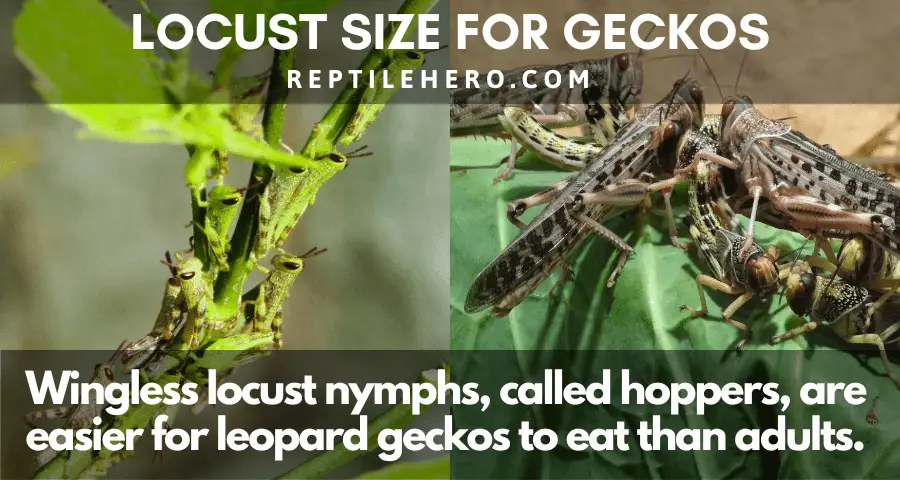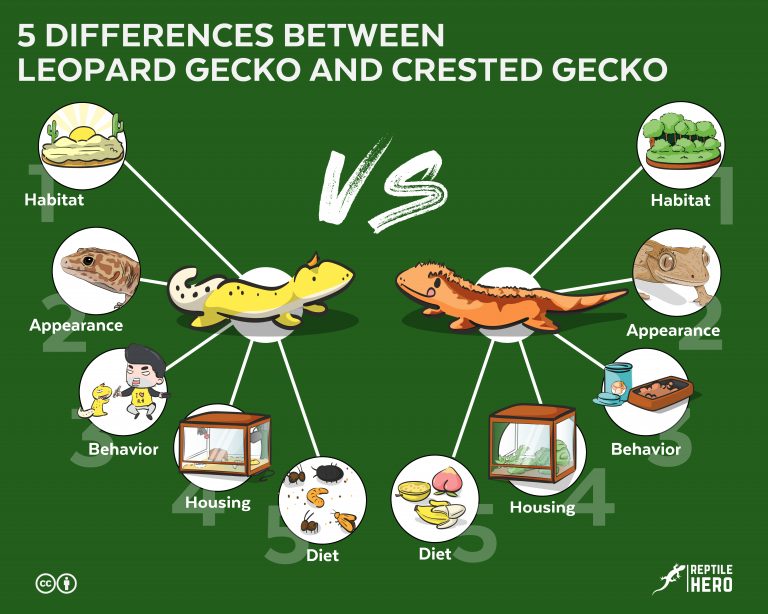Can Leopard Geckos Eat Locusts? Are They Good Live Feeders?
For most people, locusts have a horrible reputation and they trigger disgust in most of you (me included).So I was honestly shocked when I first learned that they were considered great feeders for leopard geckos! But is there actually any truth to this claim?
A leopard gecko can eat locusts as they are feeder insects rich in protein, minerals, and vitamins. However, since they are often classified as pests that can significantly damage crops, plants, and trees, locusts are not readily kept, bred, and sold in countries like America and Canada.
Since locusts can’t be bought or sold as pet food in America, are there any good alternatives to choose from? Ones that are as nutritious, if not more, as these hoppers? Continue scrolling to find out the answers before you jump to your own conclusions!
Will Leopard Geckos Eat a Locust? (What is It?)
Leopard geckos will eat locusts if presented to them as they are opportunistic insectivores. These short-horned grasshoppers can jump and fly, their movement making them highly enticing for geckos and many other insect-eating reptiles.
What most of us call locusts are actually just another type of grasshopper. These are diurnal, herbivorous, egg-laying insects from the Acrididae family with short antennas.
Unlike the smaller hoppers you know, locusts can grow up to about 5 inches (12 cm) when they’re full-grown adults [1]. Besides that, they have an interesting lifestyle that sets them apart from the regular grasshopper you’re likely more familiar with.
A locust has two distinct behavioral phases: solitary and gregarious. When there is little food available and several solitary locusts are forced to crowd together, they form a swarm that makes them more social, fast, and hungry!
Large swarms of ravenous locusts can completely destroy ecosystems [2]. But despite their less-than-stellar history and image, people from different parts of the world have eaten locusts and used them to feed various animals for over a thousand years.
Below are the 10 species of locusts normally consumed by both humans and animals:
- Australian plague locust (Chortoicetes terminifera)
- Bombay locust (Patanga succincta)
- Brown locust (Locustana pardalina)
- Desert locust (Schistocerca gregaria)
- Italian locust (Calliptamus italicus)
- Migratory locust (Locusta migratoria)
- Red locust (Nomadacris septemfasciata)
- Sahelian locust (Anacridium melanorhodon)
- Siberian locust (Gomphocerus sibiricus)
- South American locust (Schistocerca cancellata)
Of the most common species of short-horned grasshoppers, desert locusts and migratory locusts are typically used as pet food for exotic pets like geckos and lizards.
Besides your leopard geckos, cresties, tokays, bearded dragons, and many other commonly kept reptile species have been observed to enjoy not only hunting but also eating locusts!
Even in the wild, many insect-eating animals like spiders, fish, birds, amphibians, and—of course, reptiles—are known to eat locusts and other closely related grasshoppers.
Nutritional Value of Locusts (They’re Great Gecko Feeders!)
Experts recommend adding locusts to the staple diet of leopard geckos. Both captive-bred and wild locusts are high in protein and essential nutrients such as calcium, phosphorus, and vitamins A, B12, D3, and E.
As I’ve mentioned before, only migratory and desert locusts are usually used as exotic pet food. So most studies on nutrient analysis for locusts are done using them.
Check the table below to know exactly how nutritious locusts are as feeder insects for geckos.
| Dry Matter Nutrient Analysis | Captive-Bred or Wild Locust |
| Crude Protein % | 46.0–76.0 |
| Crude Fat % | 5.8–32.3 |
| Crude Fiber % | 2.5–11.0 |
| Calcium (mg/100g) | 25.7–208.4 |
| Phosphorus (mg/100g) | 171.0 |
| Potassium (mg/100g) | 101.3–749.0 |
| Sodium (mg/100g) | 27.6–281.4 |
| Magnesium (mg/100g) | 34.6–82.0 |
| Manganese (mg/100g) | 3.6–82.0 |
| Zinc (mg/100g) | 3.7–18.6 |
| Iron (mg/100g) | 2.9–8.4 |
| Copper (mg/100g) | 0.5–6.3 |
| Vitamin A (μg/g) | 0.6 |
| Vitamin B12 (μg/100g) | 10.0–20.0 |
| Vitamin D3 (μg/kg) | 0.8–2.4 |
| Vitamin E (μg/g) | 267.5 |
Locusts are not only priced for their high protein content. They also contain a decent amount of fat and fiber. So unlike a fatty insect like a waxworm, locusts can be a great addition to your precious gecko’s staple diet.
Find out more about “treat” insects in our article on waxworms.
Other than that, locusts are also rich in minerals and vitamins, like calcium and vitamin D3. In fact, locusts have more calcium, iron, zinc, and vitamin B12 than beef and pork.
However, it’s important to remember that the diet of a locust also significantly affects its overall nutritional value. Factors like their source, environmental conditions, and life stages can also have an impact on the nutrient content of locusts.
Pro Tip: Carrots improve vitamin A content in locusts but wheat bran reduces protein content!
Where Can You Get Locusts? (Plus How to Keep Them!)
In Europe, many gecko owners can buy locusts as exotic pet food from insect breeders and pet supply shops. They can be kept and bred in glass or plastic enclosures like more common insect feeders such as dubia roaches and crickets.
Ever seen gecko pet parents feeding their gecko locusts? Well, they’re likely in Europe.
They are probably living in the United Kingdom, Belgium, Netherlands, and Switzerland—or anywhere else where they can be bred and sold as food for both people and pets.
So if you can easily and legally get your hands on locusts and want to save money on feeders, in the long run, you should consider keeping a colony for your pets. By doing so, you can ensure that they are nutritious and safe for your precious leos to eat.
Here are the materials needed to create a locust bin for keeping and breeding:
- Enclosure. Locusts can be kept in a glass tank or plastic storage bin with ventilation holes similar to one dubia roaches need.
- Substrate. Having sand, soil, and coco coir as a substrate or placing it in a smaller container filled with this mix in the enclosure allows for egg deposition.
- Hides. Providing simple harborage like egg crates and decors vines and branches.
- Food. Offer a variety of fruits and vegetables to improve the nutritional value of locust feeders.
- Water. Fresh water should be available in shallow bowls and dishes to not only ensure that they stay hydrated but to also maintain optimal humidity levels.
Breeders also recommend the use of a heat mat, thermometer, and hygrometer to ensure that locusts do breed. If their environmental conditions are not kept within the ideal range they’re unlikely to reproduce [3]. They may even die!

Locusts require temperatures of 80–100°F (27–38°C) and humidity levels within 60–80% for them to fully develop and successfully breed. They are also likely to live longer in such environments.
Warning: Breeding locusts can also facilitate the development of allergies due to their frass—or feces—and various allergens which can accumulate in their wings.
Can You Buy Locusts as Pet Food in the US?
Gecko owners living in the United States of America can’t easily buy, sell, or keep locusts as feeder insects for pets. Locust swarms can have very damaging effects on crops and lands. They are considered pests and their population is heavily controlled.
Similar to many insects, you can find locusts in pretty much every part of the world except for Antarctica. In other words, you wouldn’t be hard-pressed to find them in your yard or local parks and forests.

Out of the 6,787 insect species in the Acrididae family, over 600 short-horned grasshopper species can be found in North America alone [4]. However, this doesn’t mean that you can just catch, breed, and sell them.
If you went around to ask where you can get locusts for your leopard geckos, you’d likely be answered with a resounding “nowhere” and “and you can’t.” Because of this most gecko pet parents have the impression that it is illegal to breed locusts in the US.
But once you check local government websites, you’d see that there are actually no laws regulating the collection, possession, and use of many native short-horned grasshoppers.
Still, you can’t readily get a small tub of locusts for your leos. For such cases, you could instead buy dubia roaches, discoid roaches, crickets, and mealworms.
Why are Locusts Not Commonly Available as Feeders in America?
As early as the 1950s, authorities have discussed the need to monitor and control locusts—especially in Western States like Colorado—since they can be troublesome crop pests [5].
The desert locust, in particular, has been seen as a very problematic insect that can cause devastating famines since way back all over the world. So to prevent possible famines and large-scale infestations from happening again, they are strictly monitored and managed.
For you to be able to not only possess and breed but also ship locusts between and within states, you’ll need—at least—a Plant Protection and Quarantine or PPQ 526 permit [6]. But keep in mind that some states, like Florida, may have stricter regulations for this.
Aside from that, population control with chemical sprays, which can be toxic for humans and animals, is regularly done to prevent locusts from forming massive swarms. Hence, collecting locusts from the wild is highly discouraged. The same is true in Canada.
How Many Locusts Should Leopard Geckos Eat?
Owners can feed leopard geckos with 2–10 locust nymphs, or hoppers, per meal time along with other live insects to ensure a varied diet. Locusts should be gut-loaded with gecko-safe food items 1–2 days before feeding.
To make sure that the locusts are as healthy as possible, it’s best to feed fruits and vegetables that are safe for leopard geckos for a day to a whole week. This is done to make sure that whatever food the locust has left in its guts won’t harm your leo upon eating it.
Learn more about this in our article on human foods geckos can and can’t eat.
Also, it’s best to lightly dust locusts with calcium powder and other supplements from time to time. You see, just like us, they also need to take some supplements to stay fit and strong.
Now, depending on how old your leopard gecko is, it could eat more or fewer locusts at a time. The bigger the hoppers you feed them, the less you’ll need to offer since they’ll get satiated faster. Conversely, the smaller the nymphs are, the more you can offer.

But what’s more important is to make sure that the locust you are offering them won’t be too big and tough for them to eat. Make sure that the locusts are neither wider nor longer than the space between your gecko’s eyes so that it’s easier for them to swallow.
What’s the Best Way to Feed Geckos Locusts?
To avoid locusts from escaping before they are eaten by geckos, keepers and breeders can place them in the fridge for 10-15 minutes to slow down their movement.
If you’re squeamish and can’t remove a locust’s hind legs to prevent them from jumping all over the place and escaping from you and your gecko’s grasp, this is the trick for you!
Remember, locusts and grasshoppers can jump 20 times their total body length [7]. So a 0.75-in or 1.91-cm locust, for instance, could probably go as high as 15 in or 38 cm.
Similar to many other insects, cool temperatures slow down or temporarily immobilize locusts. However, chucking locusts in the fridge for too long can kill them so keep them in there for only 15 minutes or less.
Then, you can place one locust at a time in your gecko’s tank for it to hunt for additional enrichment value. Alternatively, you could dangle it by its abdomen or a hind leg with a feeding tong while moving it around the enclosure for your gecko to follow and catch.
Discover more ways to provide enrichment for geckos!
For rescues and geckos with mobility problems due to illness—such as severe metabolic bone disease—the latter method will make it easier for the gecko to eat.
Further Questions
Is it okay to catch locusts from your garden and feed them to pet geckos?
Experts highly discourage catching locusts from the wild to offer them as live feeders for geckos. Locusts are considered crop pests so government agencies around the world normally use various methods to control their population, including chemical treatments such as insecticides and pesticides which could seriously harm geckos.
Can locusts hurt geckos?
Locusts are unlikely to hurt or bite leopard geckos. They pose little to no potential danger to animals, especially those much bigger than them, as they are herbivorous insects that prefer to eat live leafy plants. However, when food is scarce locusts may opt to scavenge for decaying plant matter and dead insects.
Are locusts expensive feeders?
Locusts are typically more expensive than crickets. A tub of 6–100 locusts can cost approximately 2–9 bucks (2–8 pounds), whereas a tub of 25–1,000 crickets only costs about 3–8 bucks (3–7 pounds). However, it’s important to consider that locusts are more or less twice as large as crickets. So fewer locust nymphs can fill up geckos faster.
How long do locusts live?
Unlike many other live insect feeders, locusts are short-lived insects that generally live no longer than a year. Although their lifespan varies from species to species, short-horned grasshoppers or locusts only live an average of 2–8 months after they hatch.
Do all locusts make noise?
In general, sexually mature locusts only make noise to attract potential breeding partners. Adult male locusts produce sounds by scraping their legs against their firm forewings. Buzzing sounds can also be heard from flying locusts. Nymphs are unable to produce such sounds as they have not yet developed wings.
Can locusts swim?
Desert locusts, Schistocerca gregaria, can swim in water using their strong and large hind legs. They can also stay underwater for up to 9 minutes without breathing. Wild bands of these short-horned hoppers normally do this when they come across bodies of water while migrating.
Summary of Can Geckos Eat Locusts
Locusts are short-horned grasshoppers that contain high amounts of protein, calcium, iron, and vitamins A and D3. As such, when possible, keepers and breeders are encouraged to give their leopard geckos up to 10 dusted locusts for each feeding.
Though locusts are believed to be illegal in America, there are no specific laws that state that they can’t be kept, bred, or sold. However, to prevent large locust swarms from forming, they are heavily managed by local and national government agencies. Moreover, permits are required for the possession and shipment of locusts.
Sources
[1] https://www.sciencedirect.com/topics/agricultural-and-biological-sciences/acrididae
[2] https://www.sciencedirect.com/science/article/pii/S2211912421000821
[4] https://mdc.mo.gov/discover-nature/field-guide/short-horned-grasshoppers
[5] https://www.govinfo.gov/content/pkg/GPO-CRECB-1958-pt12/pdf/GPO-CRECB-1958-pt12-3.pdf

![How Much Electricity Does a Gecko Use? [Full Bill Breakdown]](https://www.reptilehero.com/wp-content/uploads/2021/05/word-image-20-768x576.png)

![Is It Possible To Overfeed A Gecko? [4 Signs]](https://www.reptilehero.com/wp-content/uploads/2021/12/overfed-gecko-cc-768x614.jpg)
![8 Reasons Why You Should Not Keep A Wild Gecko as a Pet [1 Exception]](https://www.reptilehero.com/wp-content/uploads/2021/03/word-image-9-768x576.png)

![How To Properly Handle Your Geckos [6 Facts and 4 Tactics]](https://www.reptilehero.com/wp-content/uploads/2021/12/handle-your-gecko-cc-768x614.jpg)
